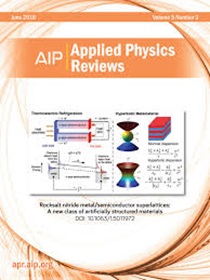Silicon carbide: A promising platform for scalable quantum networks
IF 11.6
1区 物理与天体物理
Q1 PHYSICS, APPLIED
引用次数: 0
Abstract
Quantum networks based on solid-state spin defects present a transformative approach to secure communication and distributed quantum computing, utilizing quantum entanglement and coherent spin–photon interfaces. Silicon carbide (SiC) stands out as a compelling material platform due to its unique combination of a wide bandgap, high optical nonlinearity, CMOS-compatible fabrication, and controllable spin-active defects. These intrinsic properties facilitate efficient photon emission, robust spin coherence at both room and cryogenic temperatures, and integration with photonic nanostructures. Recent advancements in defect engineering and micro-nanophotonics have unlocked the potential of SiC quantum nodes, which feature electron-nuclear spin systems for high-fidelity quantum operations and long-lived quantum memories. Key steps such as single-shot readout and spin-photon entanglement have been successfully demonstrated, bringing SiC closer to a real quantum network platform. This review offers a comprehensive overview of the advancements in SiC-based quantum networks, encompassing key aspects such as defect fabrication methodologies, optimization of spin-photon interfaces, and strategies for photonic integration. Additionally, it examines the existing challenges and outlines promising future directions in this rapidly evolving field.碳化硅:一个有前途的可扩展量子网络平台
基于固态自旋缺陷的量子网络利用量子纠缠和相干自旋光子接口,为安全通信和分布式量子计算提供了一种变革性的方法。碳化硅(SiC)由于其独特的宽带隙、高光学非线性、cmos兼容制造和可控自旋活性缺陷的组合而成为引人注目的材料平台。这些固有特性促进了高效的光子发射,在室温和低温下都具有强大的自旋相干性,并与光子纳米结构集成。缺陷工程和微纳米光子学的最新进展释放了SiC量子节点的潜力,其特点是电子-核自旋系统可用于高保真量子操作和长寿命量子存储。单次读出和自旋光子纠缠等关键步骤已成功演示,使SiC更接近真正的量子网络平台。本文综述了基于sic的量子网络的进展,包括缺陷制造方法、自旋光子界面优化和光子集成策略等关键方面。此外,它审查了现有的挑战,并概述了在这个快速发展的领域有希望的未来方向。
本文章由计算机程序翻译,如有差异,请以英文原文为准。
求助全文
约1分钟内获得全文
求助全文
来源期刊

Applied physics reviews
PHYSICS, APPLIED-
CiteScore
22.50
自引率
2.00%
发文量
113
审稿时长
2 months
期刊介绍:
Applied Physics Reviews (APR) is a journal featuring articles on critical topics in experimental or theoretical research in applied physics and applications of physics to other scientific and engineering branches. The publication includes two main types of articles:
Original Research: These articles report on high-quality, novel research studies that are of significant interest to the applied physics community.
Reviews: Review articles in APR can either be authoritative and comprehensive assessments of established areas of applied physics or short, timely reviews of recent advances in established fields or emerging areas of applied physics.
 求助内容:
求助内容: 应助结果提醒方式:
应助结果提醒方式:


